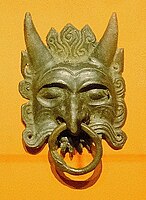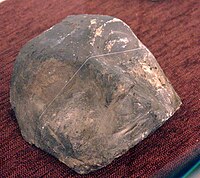Tashtyk culture
Minusinsk Depression ) and contemporary Asian polities c. 100 | |
| Geographical range | South Central Siberia |
|---|---|
| Period | Iron Age |
| Dates | 1 CE–400 CE |
| Preceded by | Tagar culture |
| Followed by | Yenisei Kyrgyz |
The Tashtyk culture
History
The Tashtyk culture was first surveyed by the Russian archaeologist
Tashtyk settlements and hill-forts have been unearthed throughout the Yenisei region, particularly the
During his excavations of the
Datation

Oglakhty is considered as "the key site of stage I of the Tashtyk culture." From the early 20th century, various dates have been proposed for the Tashtyk burials: 1st century BC-1st century CE, 1st-2nd century CE. From the 1990s, new proposals were made dating the Tashtyk burials to the 3rd–4th centuries CE.
-
Tashtyk culture mask
-
Tashtyk culture pottery
-
Tashtyk culture daggers
Genetics
In 2009, a genetic study covering specimens from the Tashtyk culture was published in Human Genetics.[7] Six Tashtyk remains of 100–400 AD from Bogratsky region, Abakano-Pérévoz I, Khakassia were surveyed, of which 5 yielded genetic ancestry and pigmentation alleles.[7]
All specimens examined were determined to be female. Extractions of
A full genome analysis on two Tashtyk mummies revealed high genetic affinity to the
-
Tashtyk culture mask reconstruction
-
Tashtyk culture mask, Khakassia National Museum.
-
A funerary mask from Tashtyk in Moscow State Historical Museum.
-
More masks in Moscow
-
Later masks, dated to the 5th-6th century.
-
Funerary masks excavated near Minusinsk, photographed in 1901.[14]
Notes
- ^ /tɑːʃˈtɪk/; Russian: Таштыкская культура
References
- ^ "Siberian Times".
- ISBN 978-0-12-809578-2.
- ISBN 978-0-7112-5914-0.
- ^ ISSN 0033-8222.
- ^ Pankova, Svetlana; Simpson, St John (1 January 2017). Scythians: warriors of ancient Siberia. British Museum. pp. 344–345.
- ^ Encyclopædia Britannica Online. Encyclopædia Britannica. Retrieved February 15, 2015.
- ^ S2CID 21347353.
- ^ a b Grousset 1970, pp. 18–19
- ^ "Xipoliya Yanke Suo Jian Xiajiesi Monijiao" ("Siberian Rock Arts and Xiajiesi's Manicheism") 1998 Gansu Mingzu Yanjiu
- ^ Zharnikova, S. V. ARCHAIC ROOTS OF TRADITIONAL CULTURE OF THE RUSSIAN NORTH: Collection of scientific articles. WP IPGEB. p. 46.
- PMC 8284818.
- . Retrieved 2023-04-29.
- ISSN 0092-8674.
- ^ Meakin, Annette M. B. (1901). A ribbon of iron. Westminster, A. Constable & co., ltd.; New York, E.P. Dutton & co. p. 105.
Further reading
- Christian, David. A History of Russia, Central Asia and Mongolia. Blackwell Publishers, 1999.
- ISBN 978-0813513041. Retrieved February 14, 2015.
- Leonid Kyzlasov. Tashtyk Era (Таштыкская эпоха). Moscow, 1953. Page 13.
- "Oglakhty". Great Soviet Encyclopaedia, 3rd ed. 1969-1978.
- "Tashtyk culture". Great Soviet Encyclopaedia, 3rd ed. 1969-1978.
External links
- Finds from Oglakhty in the Hermitage Museum[permanent dead link]
- The Tashtyk culture is presented in Hall 31 of the State Hermitage Museum (3D Tour).









![Funerary masks excavated near Minusinsk, photographed in 1901.[14]](http://upload.wikimedia.org/wikipedia/commons/thumb/6/69/Masks_from_near_Minusinsk_%28A_ribbon_of_iron%2C_1901%29.jpg/137px-Masks_from_near_Minusinsk_%28A_ribbon_of_iron%2C_1901%29.jpg)